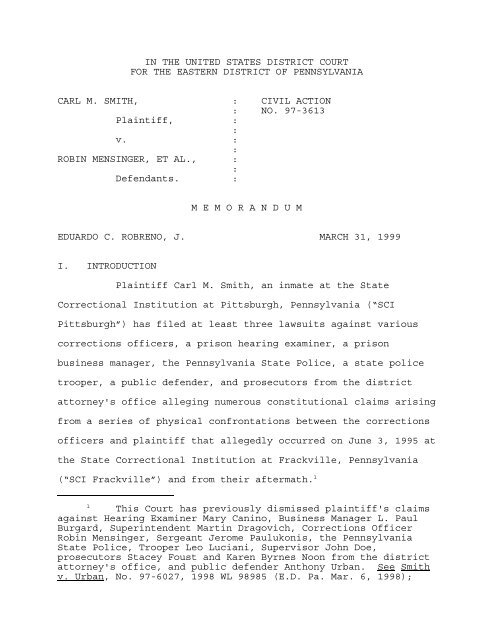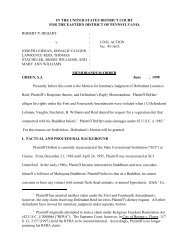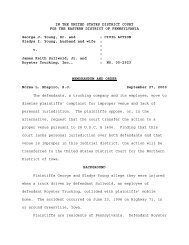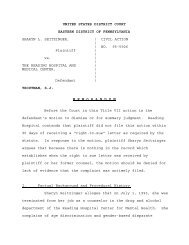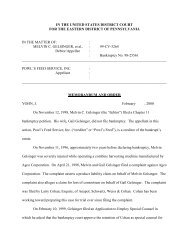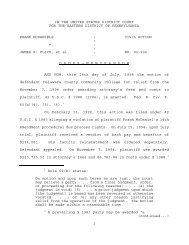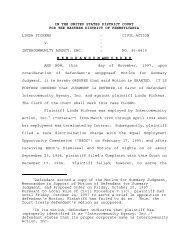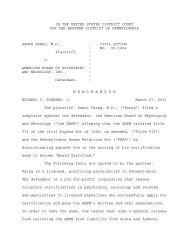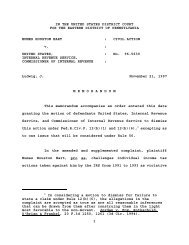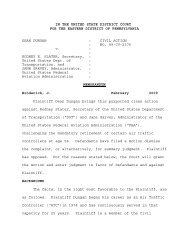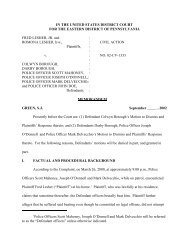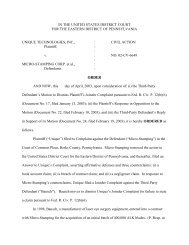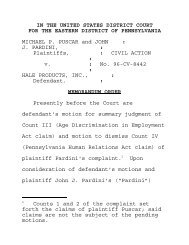This Court has previously dismissed plaintiff's claims against ...
This Court has previously dismissed plaintiff's claims against ...
This Court has previously dismissed plaintiff's claims against ...
You also want an ePaper? Increase the reach of your titles
YUMPU automatically turns print PDFs into web optimized ePapers that Google loves.
IN THE UNITED STATES DISTRICT COURT<br />
FOR THE EASTERN DISTRICT OF PENNSYLVANIA<br />
CARL M. SMITH, : CIVIL ACTION<br />
: NO. 97-3613<br />
Plaintiff, :<br />
:<br />
v. :<br />
:<br />
ROBIN MENSINGER, ET AL., :<br />
:<br />
Defendants. :<br />
M E M O R A N D U M<br />
EDUARDO C. ROBRENO, J. MARCH 31, 1999<br />
I. INTRODUCTION<br />
Plaintiff Carl M. Smith, an inmate at the State<br />
Correctional Institution at Pittsburgh, Pennsylvania (“SCI<br />
Pittsburgh”) <strong>has</strong> filed at least three lawsuits <strong>against</strong> various<br />
corrections officers, a prison hearing examiner, a prison<br />
business manager, the Pennsylvania State Police, a state police<br />
trooper, a public defender, and prosecutors from the district<br />
attorney's office alleging numerous constitutional <strong>claims</strong> arising<br />
from a series of physical confrontations between the corrections<br />
officers and plaintiff that allegedly occurred on June 3, 1995 at<br />
the State Correctional Institution at Frackville, Pennsylvania<br />
(“SCI Frackville”) and from their aftermath. 1<br />
1<br />
<strong>This</strong> <strong>Court</strong> <strong>has</strong> <strong>previously</strong> <strong>dismissed</strong> <strong>plaintiff's</strong> <strong>claims</strong><br />
<strong>against</strong> Hearing Examiner Mary Canino, Business Manager L. Paul<br />
Burgard, Superintendent Martin Dragovich, Corrections Officer<br />
Robin Mensinger, Sergeant Jerome Paulukonis, the Pennsylvania<br />
State Police, Trooper Leo Luciani, Supervisor John Doe,<br />
prosecutors Stacey Foust and Karen Byrnes Noon from the district<br />
attorney's office, and public defender Anthony Urban. See Smith<br />
v. Urban, No. 97-6027, 1998 WL 98985 (E.D. Pa. Mar. 6, 1998);
In this case, plaintiff filed a pro se complaint<br />
pursuant to 42 U.S.C. § 1983 alleging that defendants,<br />
Corrections Officers David Novitsky, Paul Androshick, Bernard<br />
McCole, James Zubris, Raymond Jones, and Jeffrey Yurkiewicz,<br />
violated <strong>plaintiff's</strong> Eighth Amendment constitutional rights when<br />
defendants utilized excessive force <strong>against</strong> plaintiff during the<br />
course of the June 3, 1995 incidents. Before the <strong>Court</strong> is<br />
defendants' motion for summary judgment, and <strong>plaintiff's</strong> motion<br />
for partial summary judgment and evidentiary hearing.<br />
I. FACTS<br />
At approximately 1:20 p.m. on June 3, 1995, when the<br />
inmates on the cell block were being let out for yard, C.O.<br />
Mensinger requested the assistance of other corrections officers,<br />
alleging that plaintiff punched her twice in the left eye. Pl.<br />
Dep. at 42. Plaintiff denies committing any assault upon C.O.<br />
Mensinger. 2 C.O. Jones and C.O. Yoder responded to C.O.<br />
Mensinger's request for assistance, whereupon C.O. Jones and C.O.<br />
Smith v. Luciani, Nos. 97-3037, 97-3613, 1998 WL 151803 (E.D. Pa.<br />
Mar. 31, 1998).<br />
2<br />
The <strong>Court</strong> notes that as a result of the alleged assault<br />
by plaintiff upon C.O. Mensinger, the Pennsylvania State Police<br />
filed a criminal complaint <strong>against</strong> plaintiff for assault by a<br />
prisoner, simple assault, and retaliation for past official<br />
actions. Prior to trial in the <strong>Court</strong> of Common Pleas of<br />
Schuylkill County, Criminal Division, the criminal complaint was<br />
amended to include a third degree misdemeanor charge of<br />
persistent disorderly conduct. Plaintiff entered a plea of nolo<br />
contendere to the charge of disorderly conduct, and the court<br />
granted the Commonwealth's motion for an entry of nolle prosequi<br />
as to the remaining charges. Defs.' Mot. for Summ. J., Ex. 2.<br />
2
Yoder handcuffed plaintiff with his arms behind his back. Pl.<br />
Dep. at 43.<br />
Defendants were to transport plaintiff to the<br />
Restricted Housing Unit (“RHU”). Before reaching the RHU, C.O.<br />
Novitsky, C.O. Androshick, C.O. McCole, and C.O. Zubris took<br />
plaintiff to the unit manager's office on the cell block until<br />
the remaining prisoners on the cell block had been released to<br />
the yard. Pl. Dep. at 54; Defs.' Ans. at 3. C.O. Jones and C.O.<br />
Yurkiewicz followed the group into the unit manager's office.<br />
Pl. Dep. at 55. While defendants were transporting plaintiff,<br />
plaintiff resisted and struggled with defendants by throwing his<br />
head and shoulders into defendants. 3 Plaintiff denies assaulting<br />
defendants. Pl. Dep. at 58. Once inside the unit manager's<br />
office, plaintiff contends that “all of [the defendants] w[ere]<br />
in back of me and they were pushing my head right into . . .<br />
cabinets and walls.” Pl. Dep. at 59. Plaintiff contends that he<br />
was knocked to the floor, where C.O. Novitsky choked him, while<br />
C.O. Yurkiewicz kicked and punched plaintiff in the buttocks and<br />
ribs. Pl. Dep. at 60-63. Plaintiff avers that C.O. Yurkiewicz<br />
and two other unnamed corrections officers then took plaintiff to<br />
a reception area, where C.O. Yurkiewicz got on top of plaintiff,<br />
3<br />
Sergeant Paulukonis issued a misconduct report <strong>against</strong><br />
plaintiff for assault due to <strong>plaintiff's</strong> throwing his head and<br />
shoulders into the corrections officers who were transporting<br />
plaintiff to the RHU. C.O. Jones, C.O. McCole, C.O. Yurkiewicz,<br />
C.O. Zubris, and C.O. Androshick issued individual written<br />
statements corroborating Sergeant Paulukonis' version of events.<br />
Pl.'s Resp., Exs. D, G. At a misconduct hearing held on June 8,<br />
1995, plaintiff was found guilty of assaulting the corrections<br />
officers. Pl.'s Resp., Ex. H.<br />
3
tightened the handcuffs causing <strong>plaintiff's</strong> wrists to become<br />
discolored, subjected him to racial epithets, and hit him on the<br />
back of the head. Pl. Dep. at 73.<br />
From the reception area, plaintiff was taken to the<br />
infirmary, where he was examined by two nurses. The medical<br />
incident/injury report shows that plaintiff complained of pain to<br />
both sides of his ribs, right ear, and right eye. Defs.' Mot.<br />
for Summ. J., Ex. 3. The nurses treated plaintiff for slight<br />
abrasions over his eyebrow and to his right forearm. Id. The<br />
report indicates that plaintiff had full range of motion of all<br />
extremities, and that there was no bleeding, marks, or bruises to<br />
<strong>plaintiff's</strong> rib area, right ear, or right eye. Id. However,<br />
plaintiff contends that his forehead was bleeding, and that his<br />
wrists and rib area were swollen for approximately two weeks<br />
after the incident. Pl. Dep. at 76-83. Plaintiff was then taken<br />
to the RHU. For two days after the alleged assault by<br />
defendants, plaintiff was seen by medical staff, where, according<br />
to the medical records, plaintiff was only treated for chronic<br />
asthma. Defs.' Mot. for Summ. J., Ex. 3. On June 6, 1995,<br />
plaintiff was medically cleared for transfer. Id.<br />
As a result of these alleged physical confrontations,<br />
C.O. Mensinger issued a misconduct report <strong>against</strong> plaintiff for<br />
allegedly punching her in the left eye. 4 Plaintiff also received<br />
4<br />
On that same day, prior to the alleged assault by<br />
plaintiff upon C.O. Mensinger, C.O. Mensinger issued another<br />
misconduct report <strong>against</strong> plaintiff for refusing to obey a direct<br />
order, using abusive or obscene language to an employee, and<br />
presence in an unauthorized area. Pl.'s Resp, Ex. E.<br />
4
a misconduct report for assault issued by Sergeant Paulukonis,<br />
which was corroborated by C.O. Jones, C.O. McCole, C.O.<br />
Yurkiewicz, C.O. Zubris, and C.O. Androshick in individual<br />
written statements, alleging that plaintiff struggled with<br />
defendants who were transporting plaintiff to the RHU by throwing<br />
his head and shoulders into defendants. Pl.'s Resp., Exs. D, G.<br />
At a misconduct hearing held on June 8, 1995, plaintiff was found<br />
guilty of both the assault on C.O. Mensinger and the assault on<br />
defendants. Pl.'s Mot. for Summ. J., Exs. D, E. Plaintiff<br />
denies assaulting the corrections officers, and avers that<br />
Sergeant Paulukonis fabricated his misconduct report to falsely<br />
justify the use of excessive force <strong>against</strong> plaintiff. Pl.'s<br />
Resp. at 5.<br />
I. LEGAL STANDARD<br />
Summary judgment is appropriate if the moving party can<br />
“show that there is no genuine issue as to any material fact and<br />
the moving party is entitled to judgment as a matter of law.”<br />
Fed. R. Civ. P. 56(c). When ruling on a motion for summary<br />
judgment, the <strong>Court</strong> must view the evidence in the light most<br />
favorable to the non-movant. Matsushita Elec. Indus. Co. v.<br />
Zenith Radio Corp., 475 U.S. 574, 587, 106 S. Ct. 1348 (1986).<br />
The <strong>Court</strong> must accept the non-movant's version of the facts as<br />
true, and resolve conflicts in the non-movant's favor. Big Apple<br />
BMW, Inc. v. BMW of North America, Inc., 974 F.2d 1358, 1363 (3d<br />
Cir. 1992), cert. denied, 507 U.S. 912, 113 S. Ct. 1262 (1993).<br />
5
The moving party bears the initial burden of<br />
demonstrating the absence of genuine issues of material fact.<br />
See Celotex Corp. v. Catrett, 477 U.S. 317, 322-23, 106 S. Ct.<br />
2548 (1986). Once the movant <strong>has</strong> done so, however, the nonmoving<br />
party cannot rest on its pleadings. See Fed. R. Civ. P.<br />
56(e). Rather, the non-movant must then “make a showing<br />
sufficient to establish the existence of every element essential<br />
to his case, based on the affidavits or by depositions and<br />
admissions on file.” Harter v. GAF Corp., 967 F.2d 846, 852 (3d<br />
Cir. 1992); see also Anderson v. Liberty Lobby, Inc., 477 U.S.<br />
242, 255, 106 S. Ct. 2505 (1986). When there are cross-motions,<br />
each motion must be considered separately, and each side must<br />
still establish a lack of genuine issues of material fact and<br />
that it is entitled to judgment as a matter of law. Rains v.<br />
Cascade Indus., Inc., 402 F.2d 241, 245 (3d Cir. 1968); see also<br />
Sterling v. Southeastern Pennsylvania Transp. Auth., 926 F. Supp.<br />
65, 68 (E.D. Pa. 1996) (citing United States v. Hall, 730 F.<br />
Supp. 646, 648 (M.D. Pa. 1990)); Wright, Miller & Kane, Federal<br />
Practice and Procedure: Civil 3d § 2720.<br />
I. ANALYSIS<br />
Plaintiff brings his claim pursuant to 42 U.S.C.<br />
§ 1983, which requires plaintiff to demonstrate that: (1) a<br />
person deprived him of a federal right; and (2) the person who<br />
deprived him of that right acted under color of state law. See<br />
Gorman v. Township of Manalapan, 47 F.3d 628, 633 (3d Cir. 1995).<br />
6
Here, plaintiff alleges that he was deprived of his Eighth<br />
Amendment right to be free from cruel and unusual punishment when<br />
defendants, acting under color of state law, unjustly utilized<br />
excessive force <strong>against</strong> plaintiff. It is undisputed that<br />
defendants were acting under color of state law. Thus, the issue<br />
is whether the force used by defendants constitutes a violation<br />
of <strong>plaintiff's</strong> Eighth Amendment rights.<br />
The Supreme <strong>Court</strong> <strong>has</strong> interpreted the Eighth<br />
Amendment's prohibition <strong>against</strong> cruel and unusual punishment as<br />
prohibiting “unnecessary and wanton infliction of pain.” Hudson<br />
v. McMillan, 503 U.S. 1, 5, 112 S. Ct. 995 (1992) (citing Whitley<br />
v. Albers, 475 U.S. 312, 319, 106 S. Ct. 1078 (1986)). To<br />
determine whether defendants violated <strong>plaintiff's</strong> Eighth<br />
Amendment rights, the <strong>Court</strong> must analyze: (1) whether defendants<br />
acted with a sufficiently culpable state of mind; and (2) whether<br />
the alleged wrongdoing was “sufficiently serious” to establish a<br />
constitutional violation. Hudson, 503 U.S. at 7. In instances<br />
where prison officials stand accused of using excessive force<br />
<strong>against</strong> a prisoner, the core issue is whether the officers' use<br />
of force was applied “in a good faith effort to maintain or<br />
restore discipline or maliciously and sadistically for the<br />
purpose of causing harm.” Id. at 6-7. Factors which may aid in<br />
determining whether the force utilized by the officers was wanton<br />
and unnecessary are: (1) the extent of the injuries suffered; (2)<br />
the need for the application of force; (3) the relationship<br />
between the need and the amount of force used; (4) the threat<br />
7
easonably perceived by the officers; and (5) any efforts made to<br />
temper the severity of the forceful response. See id. at 7.<br />
Whenever a prison official maliciously and sadistically<br />
uses force to cause harm, “contemporary standards of decency” are<br />
violated, even if the resulting injuries are not significant.<br />
Id. at 8-9. However, that does not mean that “every malevolent<br />
touch by a prison guard gives rise to a federal action.” Id. at<br />
9 (citing Johnson v. Glick, 481 F.2d 1028, 1033 (2d Cir. 1973),<br />
cert. denied, 414 U.S. 1033, 94 S. Ct. 462 (1973)). “The Eighth<br />
Amendment's prohibition of 'cruel and unusual' punishments<br />
necessarily excludes from constitutional recognition de minimis<br />
uses of physical force, provided that the use of force is not of<br />
a sort 'repugnant to the conscience of mankind.'” Id. at 9-10<br />
(quoting Whitley, 475 U.S. at 327). Accordingly, although a<br />
plaintiff need not establish significant physical injury in order<br />
to prevail on an Eighth Amendment claim of excessive force, a<br />
plaintiff must establish that his injury rises above the “de<br />
minimis level of imposition [upon constitutional rights] with<br />
which the Constitution is not concerned.” Ingraham v. Wright,<br />
430 U.S. 651, 674, 97 S. Ct. 1401 (1977).<br />
Even assuming that plaintiff could show that defendants<br />
acted with the requisite state of mind, the <strong>Court</strong> concludes that<br />
the alleged wrongdoing by defendants was not objectively harmful<br />
enough to establish a constitutional violation. Initially, the<br />
<strong>Court</strong> notes that the injuries suffered by plaintiff were<br />
relatively minor. The medical records show that <strong>plaintiff's</strong><br />
8
injuries consisted of slight abrasions to the forearm and above<br />
the eyebrow. Plaintiff also complained of soreness to the rib<br />
area and wrists, but did not require the treatment of a<br />
physician. While it is true that plaintiff was seen by medical<br />
staff at the RHU for two days after the incident, medical records<br />
reveal that plaintiff was only treated for chronic asthma, and<br />
there is no evidence showing that plaintiff ever sought or<br />
received subsequent treatment for the injuries suffered as a<br />
result of the force used by defendants.<br />
Additionally, accepting as true <strong>plaintiff's</strong> version of<br />
the facts, including being handcuffed, punched, kicked, and<br />
thrown into cabinets and walls, and given the slight injuries<br />
suffered by plaintiff, the <strong>Court</strong> finds that the incident between<br />
plaintiff and defendants involved a de minimis use of force that<br />
was not repugnant to the conscience of mankind. See, e.g., Jones<br />
v. Commissioner, No. 97-3921, 1998 WL 297636 (E.D. Pa. June 4,<br />
1998) (concluding that corrections officers used de minimis force<br />
to restrain prisoner by shoving the prisoner onto his bed,<br />
grabbing his neck, tightening his handcuffs, and punching him);<br />
Gutridge v. Chesney, No. 97-3441, 1998 WL 248913 (E.D. Pa. May 8,<br />
1998) (finding that corrections officer used de minimis force by<br />
handcuffing prisoner and pushing him <strong>against</strong> a wall); Smith v.<br />
Hulick, No. 97-801, 1998 WL 84019 (E.D. Pa. Feb. 25, 1998)<br />
(finding that prisoner's injuries, including abrasions to his eye<br />
and elbow, a cut inside his mouth, bloody lip, and sore shoulder,<br />
were de minimis); Colon v. Wert, No. 96-4494, 1997 WL 137172<br />
9
(E.D. Pa. Mar. 21, 1997) (finding that corrections officer<br />
slamming a cell door into prisoner's chest, which aggravated a<br />
pre-existing back and neck injury, was de minimis); Robinson v.<br />
Link, No. 92-4877, 1994 WL 463400 (E.D. Pa. Aug. 25, 1994)<br />
(holding that prisoner being handcuffed, dragged along a<br />
corridor, and hit in the back was de minimis); Brown v. Vaughn,<br />
No. 91-2911, 1992 WL 75008 (E.D. Pa. Mar. 31, 1992) (concluding<br />
that corrections officer striking prisoner in chest and spitting<br />
on him was de minimis). “While this <strong>Court</strong> recognizes that the<br />
lack of a serious physical injury does not bar an Eighth<br />
Amendment action, this <strong>Court</strong> also cannot ignore its strong<br />
evidentiary value.” Eppers v. Dragovich, No. 95-7673, 1996 WL<br />
420830, at *4 (E.D. Pa. July 24, 1996) (citing Norman v. Taylor,<br />
25 F.3d 1259, 1263 (4th Cir. 1994), cert. denied, 513 U.S. 1114,<br />
115 S. Ct. 909 (1995)).<br />
Moreover, the record shows that defendants reasonably<br />
perceived plaintiff to be a threat and the need for the<br />
application of force was apparent. The disturbance caused by<br />
plaintiff allegedly punching C.O. Mensinger twice in the eye, and<br />
by continually struggling with defendants attempting to transport<br />
plaintiff to the RHU, occurred when other prisoners on the cell<br />
block were not locked in their cells and were being let out into<br />
the yard. <strong>This</strong> situation created a substantially increased<br />
security risk. As such, defendants utilized the necessary amount<br />
of force to maintain and restore discipline, and prevent<br />
plaintiff from causing further harm. Although plaintiff denies<br />
10
assaulting both C.O. Mensinger and defendants, plaintiff offers<br />
no evidence in support of his denial beyond the allegations<br />
contained within his pleadings, and the record reveals that<br />
plaintiff was found guilty of both assaults at a subsequent<br />
misconduct hearing. Given the substantial security concerns<br />
associated with escorting an uncooperative prisoner, and the<br />
slight injuries suffered by plaintiff, the <strong>Court</strong> cannot<br />
reasonably find that the force used by defendants was applied<br />
maliciously and sadistically with the purpose of causing harm.<br />
I. CONCLUSION<br />
Based on the evidence on the record, the <strong>Court</strong> finds<br />
that plaintiff <strong>has</strong> not shown by a preponderance of the evidence<br />
that the force used by defendants was sufficiently serious or<br />
objectively harmful enough to establish a constitutional<br />
violation of the Eighth Amendment. Therefore, the <strong>Court</strong> finds<br />
that there is no genuine issue of material fact and defendants<br />
are entitled to summary judgment as a matter of law.<br />
An appropriate Order follows.<br />
11
IN THE UNITED STATES DISTRICT COURT<br />
FOR THE EASTERN DISTRICT OF PENNSYLVANIA<br />
CARL M. SMITH, : CIVIL ACTION<br />
: NO. 97-3613<br />
Plaintiff, :<br />
:<br />
v. :<br />
:<br />
ROBIN MENSINGER, ET AL., :<br />
:<br />
Defendants. :<br />
ORDER<br />
AND NOW, this 31st day of March, 1999, upon<br />
consideration of defendants' motion for summary judgment (doc.<br />
no. 36), <strong>plaintiff's</strong> motion for partial summary judgment and<br />
evidentiary hearing (doc. no. 52), and the responses thereto, it<br />
is hereby ORDERED that:<br />
1. Defendants' motion for summary judgment is<br />
GRANTED; and<br />
2. Plaintiff's motion for partial summary judgment<br />
and evidentiary hearing is DENIED.<br />
It is further ORDERED that <strong>plaintiff's</strong> first Rule 11<br />
motion for sanctions (doc. no. 44), <strong>plaintiff's</strong> second Rule 11<br />
motion for sanctions (doc. no. 48), <strong>plaintiff's</strong> motion to strike<br />
(doc. no. 50), and defendants' motion for protective order<br />
staying discovery (doc. no. 54) are DENIED AS MOOT.<br />
It is further ORDERED that judgment shall be entered in<br />
favor of defendants and <strong>against</strong> plaintiff. The Clerk shall mark<br />
this case CLOSED.
AND IT IS SO ORDERED.<br />
__________________________<br />
EDUARDO C. ROBRENO, J.<br />
2


